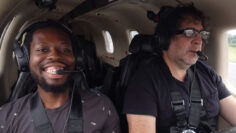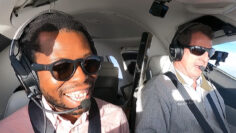The Future of Flying Taxis

Imagine a future with skies above our cities filled with birds, planes, and futuristic aircraft. This prospect is the exciting concept of urban air mobility, a revolutionary transportation system that promises to redefine how we navigate our urban landscapes. As our cities expand and encounter escalating difficulties with traffic congestion and transportation efficiency, the demand for innovative solutions becomes more pressing.
Urban air mobility, with its fleet of flying taxis, holds the potential to transform the way we move within cities. No longer confined to crowded streets, these aerial vehicles promise faster, more efficient, and eco-friendly transportation. Imagine bypassing hours of gridlock and reaching your destination in minutes, soaring above the cityscape with breathtaking views. This emerging technology is not simply a product of science fiction; it is a realistic vision for the future of transportation.

In this blog, we will delve into the urban air mobility topic and explore the exciting possibilities that flying taxis bring. From the technology behind these aerial vehicles to their potential advantages and challenges, we will uncover the factors shaping this transformative industry.
Urban Air Mobility: Redefining Transportation in Cities

One of the significant benefits of urban air mobility is its potential to alleviate traffic congestion in urban areas. Flying taxis and other aerial vehicles can avoid road traffic by taking to the skies, providing faster commuting. It not only saves time for commuters but also reduces the overall traffic burden on the ground, leading to smoother traffic flow and improved productivity.
Additionally, urban air mobility could improve city connections. Flying taxis can carry passengers straight from one place to another, despite the distance or ground-level obstacles. This technology enables efficient and seamless travel experiences, especially in areas with limited or inefficient ground transportation infrastructure.
The concept of flying taxis, also known as electric vertical take-off & landing (eVTOL) aircraft, is central to urban air mobility. These futuristic aircraft combine the convenience of helicopters with the efficiency and sustainability of electric propulsion systems. With their ability to vertically take off and land in designated areas, flying taxis can serve as on-demand air taxis, providing quick and efficient transportation within cities.
However, as urban air mobility gains momentum, we should address challenges and considerations, too. These include regulatory frameworks, infrastructure development, airspace management, noise pollution, safety measures, and public acceptance. Collaborative efforts from policymakers, urban planners, aviation experts, and technology innovators are crucial in implementing these systems.
The Technology Behind Urban Air Mobility

Urban air mobility relies on cutting-edge technologies that enable safe and efficient aerial vehicle operations in cities. Key among these innovations is the development of eVTOL aircraft. These electric-powered aircraft offer reduced noise, lower emissions, and improved energy efficiency. EVTOLs, equipped with multiple rotors or ducted fans, can vertically take off and land in urban environments with limited space.
- Supporting eVTOL operations are essential infrastructure components, including vertiports and charging stations. Vertiports, similar to helipads, serve as a convenient landing and take-off points for flying taxis. Charging station locations facilitate quick recharging between flights, ensuring availability and readiness.
- Advanced air traffic management systems are crucial for safely integrating aerial vehicles into urban airspace. These systems employ tools for traffic control, route planning, and collision avoidance, enabling efficient coordination of multiple aircraft movements in crowded skies.
- Autonomous flight technologies play a significant role in urban air mobility, enabling autonomous or semi-autonomous operations of eVTOL aircraft. With sensors, onboard computers, and AI algorithms, these aircraft navigate complex urban environments and make real-time decisions for enhanced safety.
- Advancements in lightweight materials, high-energy-density batteries, and efficient propulsion systems contribute to longer flight times and increased payload capacities.
As technology evolves, urban air mobility is becoming a tangible reality.
Advantages and Challenges of Urban Air Mobility

Urban air mobility brings potential advantages that can revolutionize transportation in cities. Some of these advantages include:
1. Reduced Traffic Congestion:
Flying taxis can bypass ground traffic, allowing for faster point-to-point travel and reducing congestion on busy city streets.
2. Faster Travel Times:
With the ability to fly directly to destinations, urban air mobility can significantly reduce travel times, especially for longer distances or during peak traffic hours.
3. Environmental Benefits:
Electric-powered eVTOL aircraft produce zero emissions during flight, contributing to cleaner air and reduced carbon footprint compared to traditional ground transportation.
4. Enhanced Connectivity:
Urban air mobility can connect remote or underserved areas with urban centers, improving access to essential services and boosting economic development.
However, the implementation of urban air mobility also comes with several challenges and considerations:

1. Airspace Management:
Coordinating the safe and efficient movement of numerous flying taxis in urban airspace requires robust air traffic management systems and regulations to prevent collisions and ensure orderly operations.
2. Noise Pollution:
Flying taxis may raise concerns about increased noise levels in urban areas. Therefore, mitigating noise pollution through quieter electric propulsion systems and careful route planning is crucial.
3. Infrastructure Requirements:
Establishing vertiports, charging stations, and maintenance facilities across cities requires significant infrastructure development and urban planning.
4. Regulatory Frameworks:
Developing comprehensive regulations that address safety, airspace management, pilot training, and certification of eVTOL aircraft is essential for the widespread adoption of urban air mobility.
Balancing the advantages and challenges of urban air mobility will be crucial in harnessing its full potential while ensuring safety, sustainability, and public acceptance.
Flying Taxis: The Future of Urban Transportation

Flying taxis represent the next frontier in urban transportation, offering a new and innovative way to navigate congested city centers. With various models and designs in development, these futuristic vehicles promise to revolutionize urban mobility. Here’s a closer look at flying taxis:
Overview of Different Flying Taxi Models and Designs: Companies like Uber, Volocopter, and Lilium diligently work on electric vertical take-off and landing (eVTOL) aircraft for urban air mobility. These vehicles feature multiple rotors or wings and vertical take-off and landing capabilities, enabling them to operate in urban environments.
Key Players in the Industry. Various companies, both well-known aerospace manufacturers and startups, are leading the charge in developing flying taxis. These include traditional manufacturers like Airbus & Boeing and emerging players such as Joby Aviation and EHang.
Implementation of Pilot Programs. Several cities and countries worldwide are piloting flying taxi programs to explore their feasibility and potential impact. For example, Dubai, Singapore, and Los Angeles have conducted test flights and are working towards integrating flying taxis into their transportation networks.
Potential Use Cases for Flying Taxis
- Transportation to and from airports.

Flying taxis can provide efficient and convenient transport for travelers, bypassing traffic congestion and reducing travel time to and from airports.
- Efficient commute within congested city centers.

Flying taxis offer an alternative mode of transportation for daily commutes, allowing people to avoid traffic and reach their destinations faster.
- Emergency medical transportation.

Flying taxis equipped with medical equipment can provide rapid response and transport for emergency medical situations enabling faster access to critical care.
- VIP and executive travel.

Flying taxis offer a luxurious and time-saving option for high-profile individuals, executives, and celebrities who require efficient and discreet transportation.
- Tourism and sightseeing.

Flying taxis can provide unique and breathtaking aerial experiences, offering tourists a new perspective of cities and landmarks.
As the technology and infrastructure for flying taxis continue developing, these use cases hold immense potential for transforming urban transportation and connectivity within cities.
FAQ Section
Are flying taxis safe and secure?
Flying taxi manufacturers prioritize safety in their designs and operations. These vehicles undergo rigorous testing and certification processes to ensure compliance with safety standards. Additionally, advanced technologies such as collision avoidance and redundant propulsion systems enhance their safety capabilities. Strict regulations and oversight from aviation authorities further contribute to the safety of flying taxis.
Are flying taxi services affordable and accessible to the general public?
As with any new technology, initial costs may be relatively high. However, as the industry grows, flying taxi services are expected to become more affordable. Companies are actively exploring innovative pricing models to make these services accessible to a bigger audience. Additionally, integration with existing transportation networks and the development of ride-sharing platforms can enhance affordability and accessibility.

How will flying taxis impact existing transportation infrastructure?
Flying taxis have the potential to alleviate traffic congestion in urban areas by offering an alternative mode of transportation. This prospect includes founding vertiports or dedicated landing and take-off places, ensuring smooth integration with other modes of transportation, and addressing airspace management and regulatory considerations.
Will flying taxis be noisy and create disturbance?
Noise pollution is a concern with any aircraft, including flying taxis. However, electric propulsion advancements and rotor design aim to minimize noise emissions. Manufacturers are working on noise reduction techniques to ensure flying taxis operate within acceptable noise limits, allowing them to coexist harmoniously with urban environments.
How soon can we expect widespread adoption of flying taxis?
The timeline for the widespread adoption of flying taxis will depend on various factors, including technological advancements, regulatory frameworks, and public acceptance. While some cities are already conducting pilot programs, achieving widespread adoption will require improvements in battery technology for longer flights and regulatory clarity. Industry experts estimate that commercial operations could become a reality within the next decade.
Conclusion

Urban air mobility and the advent of flying taxis hold immense potential to revolutionize urban transportation as we know it. With technology advancements and the increasing demand for efficient and sustainable transportation solutions, flying taxis are emerging as a promising solution for the urban mobility challenges. They offer faster travel times, reduced congestion, and environmental benefits that can significantly transform our cities.
As we look to the future, staying engaged and informed about the latest developments in urban air mobility is vital. Join the conversation, share your thoughts, and be a part of shaping the future of transportation. Explore the possibilities, delve into the discussions, and envision a world where flying taxis seamlessly coexist with traditional modes of transportation.
The era of urban air mobility is upon us, and the opportunities are boundless. Embrace the exciting possibilities, stay informed, and actively participate in the dialogue surrounding this transformative technology. Together, let’s unlock the full potential of urban air mobility and create a future where efficient, sustainable, and innovative transportation solutions redefine our cities.
Share, Engage, and Shape the Future of Urban Air Mobility

Be a part of this transformative journey. Share your thoughts, insights, and experiences with urban air mobility and flying taxis. Engage in discussions, comment on our blog, and spread the word about the future of transportation.
To stay updated on the latest developments in urban air mobility, subscribe to our newsletter and follow us on social media. Join the community of forward-thinkers, industry experts, and enthusiasts actively shaping the future of urban transportation.
Let’s embrace the exciting possibilities of urban air mobility and be at the forefront of this revolution. The sky is no longer the limit; it’s just the beginning.
Additionally, don’t forget to check out our recent blog post: “From Sci-Fi to Reality: Incredible Tech Inventions Inspired by Movies.” Gain insights into how fictional concepts have become real-life innovations, shaping the world around us.






